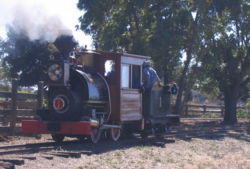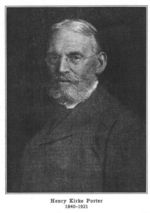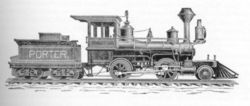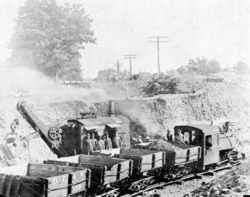H. K. Porter, Inc

H. K. Porter, Inc. (Porter) manufactured light-duty railroad locomotives starting in 1866. The company became the largest producer of industrial locomotives, and built almost eight thousand of them. The last locomotive was built in 1950, but the company continues to produce industrial equipment to this day.
Porter was known for building locomotives that were much smaller than those normally used by the larger Class I railroads. The company's locomotives were small enough that they were often operated by only one person. Porter built mostly steam locomotives, but they also built some powered by gasoline and diesel engines, and some that ran on compressed air.
The largest collection of Porter photographs and information is currently housed in the Kentlein Porter Collection at the A. C. Kalmbach Memorial Library (a service of the National Model Railroad Association) in Chattanooga, TN. Many of the 780 builder's photos, blueprints and other locomotive data were republished in Porter Steam Locomotives, published by the library.
Timeline
1866: Henry Kirke Porter forms a partnership with John Y. Smith and they call the company Smith & Porter. The two open a small machine shop on 28th Street in Pittsburgh, and begin repairing and building industrial equipment. They receive an order for their first locomotive on March 4, 1867, and build the "Joshua Rhodes" for the New Castle Railroad and Mining Company. They were to build 43 locomotives together, including the "Minnetonka" which is currently preserved in running condition at the Lake Superior Museum of Transportation, in Duluth, Minnesota. They specialized in four wheeled, saddle tank locomotives for small industrial railroads.
1871: Fire breaks out in the shop on 7 February, destroying twelve locomotives under construction, the shop, and 23 adjacent structures. Total losses were estimated at $200,000, and the partnership was dissolved. Smith went on to form Smith & Dawson Locomotives, which became National Locomotive Works. Porter formed a new partnership with Arthur W. Bell, called Porter, Bell & Co. and they built their first locomotive for the Jackson Furnace Co. of Michigan. They expanded their range to include light passenger engines and small freight engines, primarily for narrow gauge railroads. They would go on to build 223 locomotives together, until Arthur Bell died in May of 1878.
1878: Henry K. Porter continues the business on his own, as H. K. Porter & Co. By this time, he has established a reputation as a builder of rugged and very specialized locomotives. He can custom build a locomotive quickly and efficiently, because he has developed a system of interchangeable parts...pistons, wheels and boilers in various sizes that can be combined in several configurations to suit a customer's requirements. Some of the most basic designs are kept in stock, and can be ordered quite literally "off the shelf".
1890: Porter builds their first compressed air locomotive, to work in a coalmine in Pennsylvania. Compressed air was stored in two cylindrical tanks, and used to drive the pistons instead of steam. This allowed locomotive haulage inside mine tunnels without the fumes from burning coal in a boiler, or the dangers of high pressure steam. Porter went on to build over 400 compressed air locomotives for use in mines, plants, and even the street railways of New Orleans. Other builders were making compressed air locomotives, but by 1900, Porter had 90% of the market.
1899: Henry Porter incorporates the company, as the H. K. Porter Co., Inc. He builds a new and expanded plant at 49th and Harrison Street in Pittsburgh. Production peaked in 1906 with almost 400 locomotives built that year.
1911: Porter built their first gasoline powered locomotive, and in 1915 they built their first "fireless" locomotive, using a large pressure vessel to hold steam and hot water in place of a boiler. These proved to be even more useful than the compressed air locomotives, and soon Porter dominated this new niche market.
1921: The H. K. Porter Co. was prosperous, enjoying a post-WWI reconstruction boom in Europe, and a road construction boom in the United States. Porters were a favorite choice among grading contractors, who used light, portable tracks to carry the wooden tipper-cars that were the earthmoving equipment of the day. Henry Porter, still running the company at age 81, died on April 10.
1939: After a long decline, the H. K. Porter Co. declared bankruptcy. Thomas Mellon Evans purchased the company, determined to turn it around. He began buying other manufacturing companies and adding them to his collection. Locomotive porduction increased again during World War II, and the company was recognized for its service to the country in 1942, but soon after the end of the war, demand for steam locomotives dwindled, and H. K. Porter became primarily a holding company for the many subsidiaries Evans had acquired.
1950: The company built its last locomotive for an industry in Brazil. The parts business and all the required patterns were sold to the Davenport Locomotive Works in Iowa.



